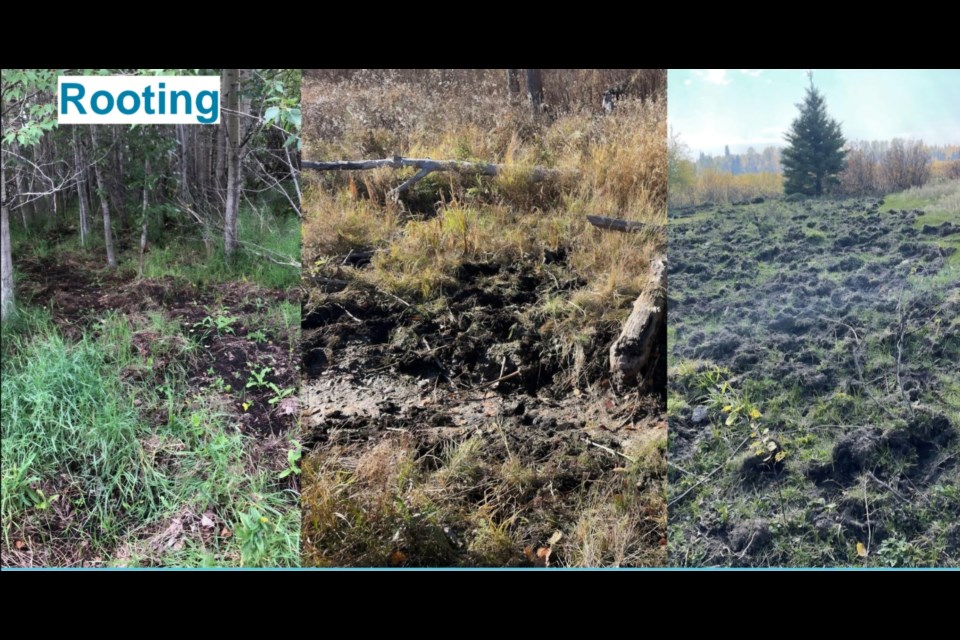Wild boars are one of the most damaging invasive species in North America and this year 77 have been trapped and removed from Woodlands County.
On Sept. 10 at the Agriculture Service Board meeting for Woodlands County Hannah McKenzie, Alberta Agriculture and Irrigation, provided an update on the current program.
“Wild Boars are such an issue because of agriculture damage they cause, the threat to our native wildlife through either competition or predation and then there is the disease threat,” stated McKenzie.
“I think this is the one (disease threat) that's really come to the front in the last couple years when this program.
“This is driven by African swine fever. Wild boars can host 39 different diseases that can be transmitted to livestock, humans and wildlife.”
Alberta Pork has hired trappers specifically to address the wild boars. Training has been completed with trappers in July and they are ready to follow up on new sightings.
Chris Arndt is the trapper supporting Woodlands County and surrounding areas.
When a wild boar is spotted it needs to be reported so the team can trap and remove it from the area and then determine if it is a lone boar or part of a pack (sounder).
All reports in Woodlands County have been feral wild boars.
Groups of wild boars can grow to 30 animals or more and they breed all year with at least six piglets per litter according to McKenzie.
Wild boars were brought into the country as a diversified livestock in the 1980s and by 2008 wild boars were listed as pests under the Agricultural Pest Act.
2016 they were tasked to define a comprehensive program to address the wild boar situation and in 2022 the Wild Boar Control Program was established.
The Squeal on Pigs program was established to report wild boar sightings.
“They have removed 303 wild boars from Woodlands County over the last seven years from 2018 to present.
413 were removed across the province and the majority of those were coming from Woodlands County,” stated McKenzie.
There were 21 wild boars removed from the County of Barrhead through the 2003-2015 bounty program.
There have been no reported sightings in the County of Barrhead.
That doesn’t mean there are no wild boars, just that there are no reports of sightings.
Legally landowners and the local authority must actively prevent establishment and control or destroy of the pests.
Even though it is legal to hunt them, the program encourages residents to report the sighting of wild boars and enable the trained trappers to handle the removal and disposal of wild boars.
Alberta Pork has a program where they will provide community members with cameras to observe areas where wild boar have been spotted.
People with outdoor pigs or outdoor access can contact Alberta Pork to get involved. A camera will be provided to monitor for wild boars and after a year the camera is the landowners to keep in recognition of their participation in the program according to McKenzie.
“We want to engage hunters to get the information, but we don't really want to encourage them to be shooting at a group of wild boars,” said McKenzie.
The information hunters can provide is really valuable to monitoring where the wild boars are being seen so the program can get on top of where they are located.
Councillor Deane said hunters have found skulls and questioned if that would be important information to share and McKenzie confirmed that any information or stories of sightings is helpful.
McKenzie explained that they have been increasing the number of tools they have on hand to trap and monitor wild boars.
Wild boars are mostly brown or black with coarse bristly hair. They may have white-tipped bristles in their coat. Their ears stand straight up, and they have long straight snouts.
They may have darker portions on their legs, ears and snouts. They grow to three feet high and five feet long. Males have larger heads and tusks. Piglets are striped.
Wild boar hoof tracks look like deer tracks, but rounder. When the dew claw's prints are present in the track, they are off to the side instead of in line with the hoof print like deer.
They like to wallow in muddy water so look for areas with wild boar prints around standing water in muddy areas.
Wild boars root in areas digging up large areas causing lumps in the terrains.
Their nests are piled grasses somewhat like a round shape and can be found at the edge of a tree or out in the open.
When you see a wild boar report it at 310-FARM (310-3276) or email [email protected].
“Public reports are really critical,” remarked McKenzie, “all reports are investigated.”



